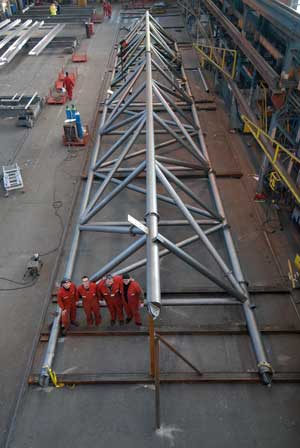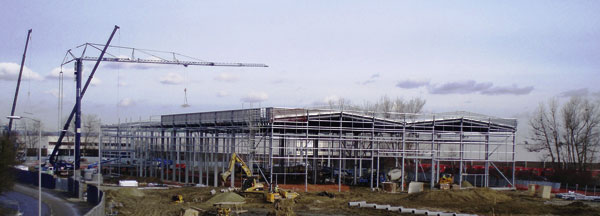Projects and Features
Early involvement helps manage price instability
Despite misperceptions that steel price rises were different from those of other materials, steel remains the cost-effective framing material of first choice. Nick Barrett reports that communication and collaboration with clients and all along the supply chain are proving a winning strategy.
NSC’s last update on steel prices and availability in the summer was against a background of global rising raw material prices affecting all construction materials; consequent price rises in concrete, timber, plastic products and steel; and shortages, threatened and otherwise. Despite the fact that all construction materials have been affected, steel seemed to be getting singled out for the more alarmist stories about price rises, while lower technology materials like concrete and timber never attract the same attention.
Steel is frequently in the news, usually when either large investments are made in steelworks, or manufacturing job losses are threatened. “The plain fact that steel prices are as stable as any other construction material, and that its supply chain is well-founded, always seems to have to be argued against a background of misinformation implying that steel is doing worse than other materials in terms of price or availability,” says BCSA President Mark Denham, Chairman of Elland Steel Structures.
“In fact, the true situation is the reverse of that. The proof is seen in the regular costs analysis carried out by independent researchers like AECOM, whose latest update will be issued shortly”.
Developers and other clients are keen to use steel, convinced of its sustainability advantages that the sector has been advising on for many years; but further carbon reduction action is demanded by the climate change crisis. The COP26 meeting in Glasgow has highlighted the crucial need to combat climate change by reducing carbon emissions in all of our activities, including manufacturing, construction of buildings and infrastructure, heating our homes and public buildings and transport.
The entire steel supply chain is acutely aware of the need to make its contribution, and is making every effort to minimise carbon impacts, starting from design, through manufacture, construction, operation and eventual decommissioning, which might involve demolition and, for steel, recycling or re-use. Other construction materials will never achieve the re-use and recycling – and without degradation of the material’s properties – that steel delivers.
Steel’s Net-Zero Roadmap
Steel construction is in strong demand to deliver projects in fast-growing, key sectors of the economy while providing the high sustainability credentials which are highlighted by the BCSA’s Net-Zero Roadmap that is summarised in this issue of NSC (see page 16). The Roadmap spells out the steel construction sector’s commitment to achieving net-zero carbon by 2050, decarbonising operations in line with government ambitions. Steel manufacturers like BCSA industry members Tata Steel and British Steel are also making their own efforts to support the global push to combat climate change.
Steelwork contractors say the strength of their supply chain has been proven in recent months as supplies of sections and most other steel products have been maintained. Communication with clients has been key in helping them understand the global problems affecting supply; after a short-lived pause by some, while the implications of price rises and supply issues were absorbed, client confidence has been revealed as strong.
Steve Duffield, Group Sales Director of William Hare, said: “Our workshops are fully staffed by locally-employed specialists and there are no labour supply challenges to be met. Site erection is swiftly carried out by small, highly-skilled specialist teams, minimising time spent on site. For steel construction, just-in-time deliveries of offsite fabricated sections as demanded by modular construction, is just the normal way of working.
“Issues have been explained in regular conversations with clients, who tend to be realistic business people, and they appreciate the issues and what we are doing to help. They now realise that other materials prices are rising rapidly, and are taking a cooperative and long-term approach.”
Client confidence remains high and new orders are flowing through steelwork contractors. Caunton Engineering is typical, where Executive Chairman Simon Bingham says orders are being booked now for the third quarter of 2022. “The message about getting your steelwork contractor involved early is getting through. Clients used to order materials and services sequentially in line with the construction programme, but they have learned to order the element with the longest lead-in first, so steel comes higher up on the priority list. Procurement is becoming more strategic.
“We have heard that alternative materials had been looked at by client’s estimating teams, but steel is still emerging as the best option. We haven’t suffered any drop off in orders or our ability to deliver to clients on time and to budget.”
Power of steel supply chain
Steve Govier, Chief Executive of Bourne Group says the power of the steel construction supply chain has been proven in recent months as availability of steel is not an issue. “Availability issues are behind us, the supply process has been de-risked. Enough of world steel manufacturing capacity is back on stream and we have been able to allay any client concerns. Communication and collaboration have helped enormously.
“We have never faced problems with securing drivers to take materials to site and the erectors are our own highly-trained employees. Prices for steel have stabilised, particularly for steel sections, and temporary surcharges have been manageable. Steel manufacturers are able to make profits now for the first time in a number of years, which is essential to pay for innovation and carbon-reducing investments.”
Mr Govier confirms that clients are responding well to the case made for issuing early instructions. “Buying materials in advance locks prices in, although not all clients are able to do that. We see demand rising across the board and despite short-term anxieties earlier in the year, steel is still wanted by its customers.”
Mr Duffield confirms that prices have settled, there are no supply problems and the market is active. “British Steel adding their temporary surcharge was a highly visible event, which helps us as all of our customers can see why we had to increase prices. There was some misinformation being spread at one time about the length of lead times for steel, but there are no issues with steel supply.
“We look at projects differently now from a procurement point of view, and have convinced clients that it is important to pin prices down as soon as possible, and focus on the quality and quantities of steel that will be needed. That knowledge then helps the manufacturers plan production. This is the sort of collaboration that helps us all.
“Early engagement has never been more important, it is key. Pressing the button at the last minute is not the way the market operates any longer.”
Mark Smith, Chief Executive of Billington Holdings says after being ‘blindsided’ by some of this year’s price rises, prices have stabilised. “Price is still an issue but no more so than other materials like concrete and timber. We talk to client’s cost consultants regularly so they can have up-to-date information. We identify the critical supply elements of their projects and negotiate fluctuation clauses when appropriate. Regular contact and positive conversations with customers have been helpful.
“There are some inefficiencies in the construction supply chain being caused by driver shortages affecting deliveries, however, these have improved greatly working closely with our supply partners. We are all planning ahead more than before, which helps the whole supply chain and ultimately our customers.”















